Contents
Hardwood Slug Mold for Chamber Impact Slugs
Any source of hardwood material will do. Hardwood flooring, old ax handles (one cavity mold), seasoned firewood (needs to be sawed to usable size and shape), etc.
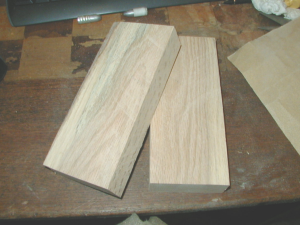
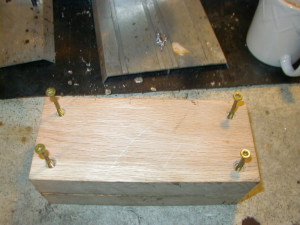 The mold in this example was selected from dry, seasoned White Oak slabs that I use for firewood. I used a table saw to shape a nice piece into a smooth uniform block that was pre drilled for corner wood screws and then sawed into two equal halves to create a temporary mold for casting impact slugs for four different chambers. ( 25-20, 30-30, 38-55 and 45-70).
The mold in this example was selected from dry, seasoned White Oak slabs that I use for firewood. I used a table saw to shape a nice piece into a smooth uniform block that was pre drilled for corner wood screws and then sawed into two equal halves to create a temporary mold for casting impact slugs for four different chambers. ( 25-20, 30-30, 38-55 and 45-70).
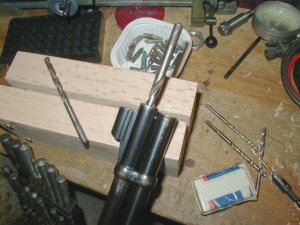
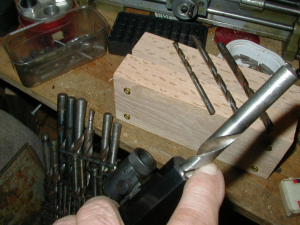 Carefully slide the shank of different sized drill bits into the bore of each firearm that you plan to use for an impact impression. (My drill bits have dings on the shank so I carefully slid the flute sections into the bore to check for fit. If you do this,be very careful to avoid damage to the riffling and barrel crown.)
Carefully slide the shank of different sized drill bits into the bore of each firearm that you plan to use for an impact impression. (My drill bits have dings on the shank so I carefully slid the flute sections into the bore to check for fit. If you do this,be very careful to avoid damage to the riffling and barrel crown.)
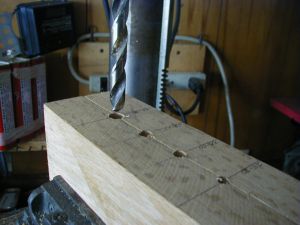
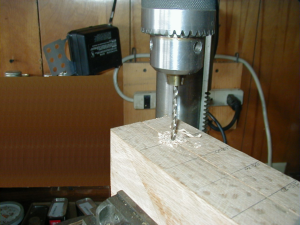 Tighten the mold alignment screws then chuck a small pilot drill into a drill press and drill a pilot hole for each selected drill bit size. If using a hand drill, tighten the alignment screws enough to leave a small space between the mold halves to center and guide the pilot drill . When the pilot holes are drilled, carefully align and drill the holes to bore size with the pre selected drill bits.
Tighten the mold alignment screws then chuck a small pilot drill into a drill press and drill a pilot hole for each selected drill bit size. If using a hand drill, tighten the alignment screws enough to leave a small space between the mold halves to center and guide the pilot drill . When the pilot holes are drilled, carefully align and drill the holes to bore size with the pre selected drill bits.
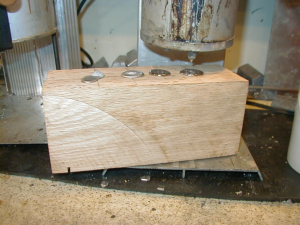
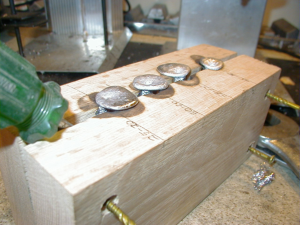 Heat the pure lead alloy to about 50 degrees above melt temperature. (The hotter the lead, the more charring will occur in the cavities so keep the alloy relatively cool). Pour enough lead into each cavity to leave a small puddle on the top of the mold. Unscrew the guide screws, use a screwdriver to pry apart the mold halves then use a hammer and punch to strike the slugs on the sprue portion to remove them from the blocks.
Heat the pure lead alloy to about 50 degrees above melt temperature. (The hotter the lead, the more charring will occur in the cavities so keep the alloy relatively cool). Pour enough lead into each cavity to leave a small puddle on the top of the mold. Unscrew the guide screws, use a screwdriver to pry apart the mold halves then use a hammer and punch to strike the slugs on the sprue portion to remove them from the blocks.
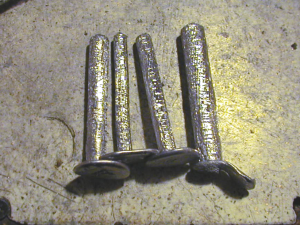
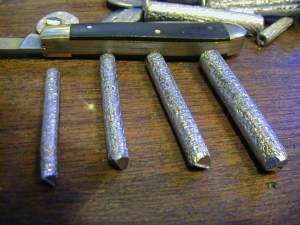 Straighten the slugs, scrape off any flashing and whiskers then roll each slug between the back half of the mold sections to further even and smooth the slugs. Cut each slug to a suitable length for each caliber.
Straighten the slugs, scrape off any flashing and whiskers then roll each slug between the back half of the mold sections to further even and smooth the slugs. Cut each slug to a suitable length for each caliber.
Copyright © 2014. TMT Enterprises. All rights reserved.

 The mold in this example was selected from dry, seasoned White Oak slabs that I use for firewood. I used a table saw to shape a nice piece into a smooth uniform block that was pre drilled for corner wood screws and then sawed into two equal halves to create a temporary mold for casting impact slugs for four different chambers. ( 25-20, 30-30, 38-55 and 45-70).
The mold in this example was selected from dry, seasoned White Oak slabs that I use for firewood. I used a table saw to shape a nice piece into a smooth uniform block that was pre drilled for corner wood screws and then sawed into two equal halves to create a temporary mold for casting impact slugs for four different chambers. ( 25-20, 30-30, 38-55 and 45-70).
 Carefully slide the shank of different sized drill bits into the bore of each firearm that you plan to use for an impact impression. (My drill bits have dings on the shank so I carefully slid the flute sections into the bore to check for fit. If you do this,be very careful to avoid damage to the riffling and barrel crown.)
Carefully slide the shank of different sized drill bits into the bore of each firearm that you plan to use for an impact impression. (My drill bits have dings on the shank so I carefully slid the flute sections into the bore to check for fit. If you do this,be very careful to avoid damage to the riffling and barrel crown.)
 Tighten the mold alignment screws then chuck a small pilot drill into a drill press and drill a pilot hole for each selected drill bit size. If using a hand drill, tighten the alignment screws enough to leave a small space between the mold halves to center and guide the pilot drill . When the pilot holes are drilled, carefully align and drill the holes to bore size with the pre selected drill bits.
Tighten the mold alignment screws then chuck a small pilot drill into a drill press and drill a pilot hole for each selected drill bit size. If using a hand drill, tighten the alignment screws enough to leave a small space between the mold halves to center and guide the pilot drill . When the pilot holes are drilled, carefully align and drill the holes to bore size with the pre selected drill bits.
 Heat the pure lead alloy to about 50 degrees above melt temperature. (The hotter the lead, the more charring will occur in the cavities so keep the alloy relatively cool). Pour enough lead into each cavity to leave a small puddle on the top of the mold. Unscrew the guide screws, use a screwdriver to pry apart the mold halves then use a hammer and punch to strike the slugs on the sprue portion to remove them from the blocks.
Heat the pure lead alloy to about 50 degrees above melt temperature. (The hotter the lead, the more charring will occur in the cavities so keep the alloy relatively cool). Pour enough lead into each cavity to leave a small puddle on the top of the mold. Unscrew the guide screws, use a screwdriver to pry apart the mold halves then use a hammer and punch to strike the slugs on the sprue portion to remove them from the blocks. 
 Straighten the slugs, scrape off any flashing and whiskers then roll each slug between the back half of the mold sections to further even and smooth the slugs. Cut each slug to a suitable length for each caliber.
Straighten the slugs, scrape off any flashing and whiskers then roll each slug between the back half of the mold sections to further even and smooth the slugs. Cut each slug to a suitable length for each caliber.